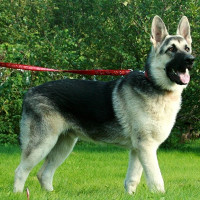Appearance of the Eastern European Shepherd
|
| While the East European Shepherd closely resembles a German Shepherd in appearance, the East European Shepherd is larger and heavier than the German Shepherd. The Eastern European Shepherd has a massive head with large, erect ears, big, bright, inquisitive brown eyes and a denser coat than its counterpart. This dense coat, with its soft undercoat, enables this working dog to withstand winter temperatures. They have a strong, muscular body, with a straight back sloping slightly towards the tail, which is long and soft. Their chest is moderately deep and their belly tucked up. Their legs are straight and strong, and their feet are oval and well padded. Eastern European Shepherd Dogs have a wolfish appearance with an alert, steady and intense gaze. They have a slightly rounded forehead and a long muzzle with impressive large teeth set in a powerful jaw with a scissor bite. The colors of this breed include the Russian KGB favorite, solid black, but they also come in black and tan with a black mask, as well as black and red, or even sandy gray or sandy red, which is rarer. |
Temperament of the Eastern European Shepherd
|
| Versatile, robust, loyal, protective and playful are just some of the words used to describe the East-European Shepherd. This breed is an intelligent dog that needs a strong leader/owner to get the best out of it. Being a big dog, they can be a bit stubborn unless they have someone up to the task. They were used in the army in the USSR, particularly appreciated by the KGB, who loved this imposing, calm and intense dog, but also in police work, search and rescue and even as a guide dog for the blind. Intelligent and devoted, they will be protective of owner and family, but can remain wary and aloof of others. They need to be well socialized when young to understand acceptable behavior with other dogs and people. The European Shepherd is a confident dog, well suited to colder climates. Although wolf-like, and imposing in statue when fully grown, they remain puppies in the minds of their beloved owners. They'll guard your home, your vehicle, your family and even other pets. Speaking of which, they generally get along well with other dogs, but some can be troublesome with cats unless they're bred together. Beautiful, gorgeous and with a lovely appearance and stable temperament without unnecessary aggression, they really are a breed we need to see more of. |
Needs and activities of the Eastern European Shepherd
|
| The East-European Shepherd loves to be active and longs for a good walk or two every day. It's a dog that lives for work and responds well to training from a respected owner. At home, they are lively, playful and amusing, but can become boisterous and unwittingly surprise family members with their exuberance. The East European Shepherd would make an ideal running companion, happily scampering alongside you. No one disturbs you under their protective gaze. They are ideal for obedience competitions, agility and other dog sports that involve following orders and using their high intelligence to solve problems. A yard or acreage is preferable for this athlete, as an apartment is a little too confining for this super dog. |
Maintenance of the Eastern European Shepherd
|
| The East-European Shepherd is a constant shedder, so if you can't tolerate hair at home, it may not be your dog. They have a thick, dense coat with a soft undercoat that will require brushing at least twice a week to keep it in good condition. Bathing is not often necessary, as it can interfere with the natural oil protection in the coat that protects the dog from the cold. If you do bathe this dog, use a mild dog shampoo for best results. As this dog can grow to a very large size, train him as a puppy, familiarize him with brushing his teeth and clipping his nails, and wipe his ears. It's easier to teach a puppy than try to educate a slightly more wary dog. The East European Shepherd is a devoted member of the family and will be a happy dog if he gets regular exercise and has a job to do, such as watching the property. |







 English (United Kingdom)
English (United Kingdom)